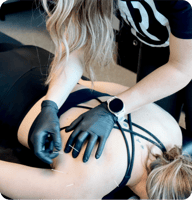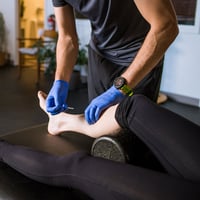If you’ve ever had someone mention dry needling, you may have wondered—wait, isn’t that just...
What Is Dry Needling? How It Works & What to Expect
If you’ve ever dealt with stubborn muscle tension, tightness that stretching can’t fix, or pain that keeps showing up during runs or workouts, someone may have recommended dry needling. But what exactly is it—and how do you know if it’s right for you?
At Steady State Health, we use dry needling as part of our performance-based physical therapy approach. It’s not a cure-all, but for many of our clients—especially runners and active adults—it’s a powerful tool for moving better, recovering faster, and breaking out of chronic pain loops.
What Does Dry Needling Do?
Dry needling is a contemporary physical therapy technique used to treat musculoskeletal pain. It involves placing thin, sterile needles into muscle tissue—specifically, trigger points or areas of tightness that are often areas of knotted or dense muscle tissue. The goal of dry needling is to release tension in these spots, alleviate pain, and improve mobility.
Unlike acupuncture, which is rooted in traditional Chinese medicine, dry needling is based on modern anatomy and neuroscience. It’s a mechanical and neurological intervention—not an energy-based one.
In short, what dry needling does is help reduce neuromuscular tension, restore movement, and create an opportunity for your body to relearn how to move without pain.
Dry Needling Benefits
When integrated into a comprehensive physical therapy plan, dry needling can help with:
- Releasing chronically tight muscles that limit mobility or cause compensation
- Decreasing pain sensitivity in specific areas, especially those impacted by overuse
- Improving range of motion and movement efficiency
- Accelerating recovery after intense training or injury
- Supporting nervous system regulation by calming overactive muscle patterns
We often use it alongside other treatments like strength training, education around training, manual therapy, and mobility work to support long-term resilience—not just short-term symptom relief.
Pros and Cons of Dry Needling Benefits
Pros
- Targets hard-to-reach muscle tissue with precision
- Often provides quick relief in areas that have plateaued with traditional treatment
- Integrates well into a broader performance or rehab plan
- Non-pharmaceutical, non-surgical, and safe when performed by trained clinicians
Cons
- May cause soreness for 24–48 hours post-treatment
- Results can vary depending on underlying factors like load, form, or strength
- Not a standalone solution—should always be paired with movement and strength work
-
Not appropriate for everyone, such as needle-phobic individuals or certain health conditions
We never recommend dry needling in isolation, and we won’t use it unless it makes sense for your goals, comfort level, and clinical picture.
What to Expect During a Session
If dry needling is part of your plan, here’s what you can expect:
-
Assessment first: We’ll evaluate your movement, symptoms, and goals before ever picking up a needle.
- Personalized treatment: We only needle areas that are relevant to your specific movement patterns or dysfunctions.
- Sensations: You may feel a twitch response or brief muscle ache during treatment—this is normal and usually short-lived.
-
Aftercare: Soreness is possible (like a deep muscle workout), and we’ll guide you on how to recover and keep progressing.
Most people feel relief quickly, but dry needling works best as part of a bigger plan—one that includes strength, movement retraining, and education.
Is Dry Needling Right for You?
We use dry needling most often for runners and active adults dealing with:
- Recurring calf, hamstring, or glute tightness
- Low back or hip pain that hasn’t improved with stretching alone
- Post-surgical muscle guarding or compensation
- Stubborn pain patterns with running, lifting, or high-impact movement
If you're curious but unsure, we’re happy to talk through whether dry needling makes sense for you during a free discovery call.
Work With a Provider Who Gets It
At Steady State Health, dry needling is just one piece of the puzzle. We combine it with strength-forward rehab, running-specific care, and clinical decision-making that reflects your goals—not just your symptoms.





